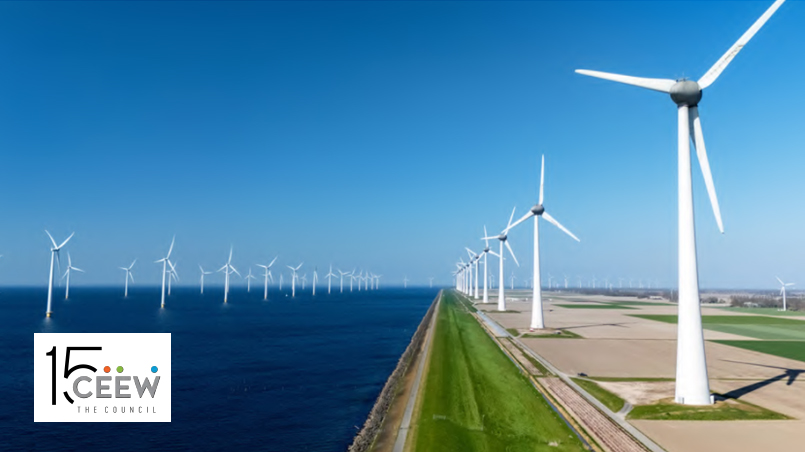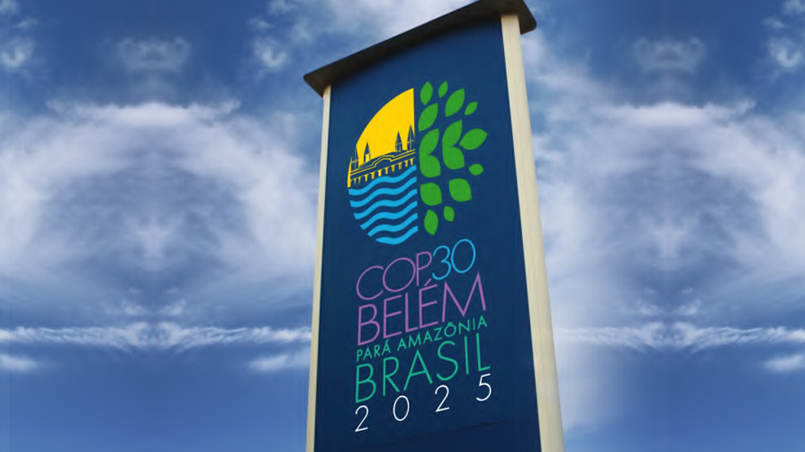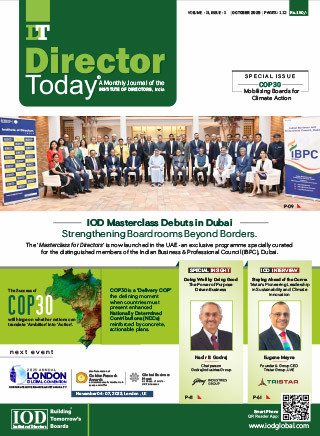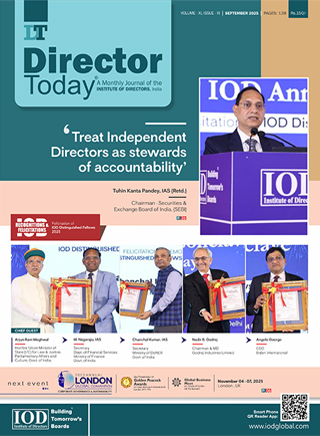Climate is the Economy Now

South Asia is already living the reality of climate extremes, from floods to heatwaves that disrupt supply chains and productivity. Over the decade (from 2014 to 2023), such climate extreme events cost the global economy an estimated USD 2 trillion. But this story is not just one of devastation. The sustainability transition is also bringing jobs and growth. A new BCG survey shows that 82 per cent of companies are already reporting economic gains from decarbonisation. Further, the transition to a resilient, low-carbon world will be among the primary drivers of future competitiveness, market creation, and value generation.
The question for boardrooms is not ‘if’ to engage, but how to lead. In India, corporate renewable capacity now exceeds 45,000 MW, cutting costs and lifting margins. Nearly 68 per cent of exports tied to net-zero committed countries, Decarbonisation is now the price of competitiveness.
Globally, the stakes are higher. Over half of global GDP, USD 58 trillion, is at risk from ecosystem decline. Investing in resilience is proving cheaper than absorbing such shocks. Three shifts will shape the future: resilience as the least-risk path, Supply chains built on interdependence not protectionism, and circular Economies turning waste into strategic advantage. For directors, these are not abstractions but signals of where markets and capital will flow next.
Here’s how to reframe the challenge.
First, redefine resilience as strategic infrastructure in a world with climate extremes. Extreme weather is a tangible drain on the bottom line, disrupting operations and impacting assets such as factories. Building resilience, and not just retrofitting, now is a direct investment in business continuity.
In India, corporate renewable capacity now exceeds 45,000 MW, cutting costs and lifting margins. Nearly 68 per cent of exports tied to netzero committed countries, Decarbonisation is now the price of competitiveness.
The Asia Pacific region accounted for nearly half of all global economic losses from disasters - a staggering USD 2.7 trillion from 1970 to 2022. In 2024 alone, natural catastrophes caused USD 320 billion in losses, but only USD 140 billion (around 40 per cent) was insured. For individual companies, this manifests as a “protection gap.” Three out of four Indian districts are already vulnerable to extreme events such as floods, droughts, cyclones, and heatwaves. Executive leadership must champion investing in resilience, not just in your own facilities, but across your value chain. This means proactively working with suppliers in vulnerable geographies and commercialising the solutions, from climate-risk insurance to water-efficient technologies, that other corporations will desperately need. It is the best strategy for de-risking operations.
Second, integrate climate into your core value proposition. The companies that will define the next decade are those that treat climate not as a risk to be mitigated, but as a market to be leveraged. Emerging and developing economies will account for nearly 70 per cent of global energy demand growth over the next decade, underscoring where the markets of the future will be. This requires fundamentally aligning products and services with the demands of a transitioning world.
Consider the data: Research by the Council on Energy, Environment and Water (CEEW) finds that the number of Indians employed in clean energy sectors increased by 47 per cent in 2021-22 and continues to grow steadily. The investment opportunity in renewables, electric mobility, and green hydrogen is at least USD 500 billion until 2030. But it goes beyond energy. India’s bio-economy has exploded from USD 10 billion in 2014 to USD ~166 billion today, projected to reach USD 300 billion by 2030. This is not abstract; it's happening now. Consider Guwahati-based Bamboostan, transforming 80,000 MT of local bamboo annually into construction material while raising farmer incomes, or Eco Recycling Limited’s Maharashtra facility, which annually recycles 25,000 tonnes of e-waste.
Directors must ask: Is our R&D and mergers and acquisitions strategy aligned to build, buy, or partner into these growth areas? This is about anticipating where demand will flow and building sustainable supply chains.
Third, deploy capital where the future is cheaper. The old debate on whether the transition is affordable is obsolete. The numbers are clear: Clean energy is the cheapest source of new power, and businesses going green are seeing profits and market competitiveness. In India, competitive reverse auctions drove solar tariffs from INR 20 per unit 15 years ago, to just over INR 2 today, among the lowest globally. India’s latest auctions confirm that solar coupled with battery storage is now cheaper than building new coal capacity. Nearly half of global companies investing in climate-risk adaptation are already seeing returns above ten per cent; proof that capital deployed in the transition is not just impact-driven but commercially sound.
The COP30 agenda in Belém - anchored in the Baku to Belém Roadmap to mobilise USD 1.3 trillion annually in climate finance - offers a prospectus for this new calculus. But this is no longer a task for national governments alone. The most dynamic leadership is now emerging from cities mandating green building codes, regions launching carbon markets, and, most critically, corporations structuring credible transition plans.
India's bio-economy has exploded from USD 10 billion in 2014 to USD ~166 billion today, projected to reach USD 300 billion by 2030.
That capital will flow to the economies and the companies that demonstrate real-world readiness. The firms that will win are those already securing long-term offtake agreements for green hydrogen, issuing sustainability-linked bonds, setting internal carbon prices and leveraging South–South financial conduits.

With India’s energy demand set to outpace the European Union by 2030 and almost 70 per cent of its exports linked to net-zero-aligned markets, the imperative is strategic, not optional. The transition is being buttressed by robust policy, innovative finance, and integrated corporate strategies. The question for Indian business leaders is no longer about the cost of action, but about the cost of being left behind. The future belongs to those who build it sustainably.
Author

Dr. Arunabha Ghosh
COP30 Special Envoy for South Asia and the founder-CEO of the Council on Energy, Environment and Water (CEEW). He is an internationally recognised public policy expert, author, and institution builder. He previously worked at Princeton, Oxford, UNDP (New York), and WTO (Geneva).
Owned by: Institute of Directors, India
Disclaimer: The opinions expressed in the articles/ stories are the personal opinions of the author. IOD/ Editor is not responsible for the accuracy, completeness, suitability, or validity of any information in those articles. The information, facts or opinions expressed in the articles/ speeches do not reflect the views of IOD/ Editor and IOD/ Editor does not assume any responsibility or liability for the same.

 Quick Links
Quick Links
 Connect us
Connect us




 Back to Home
Back to Home






























